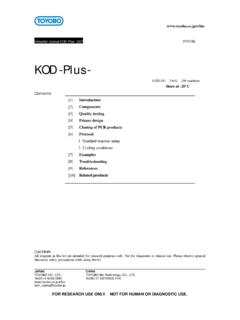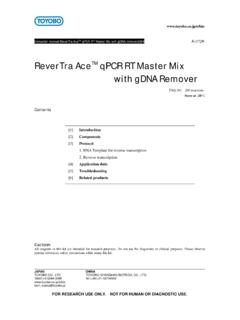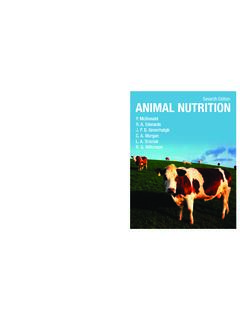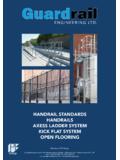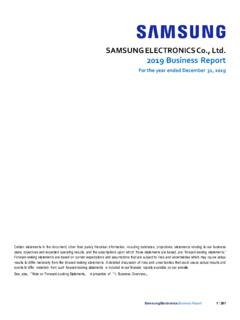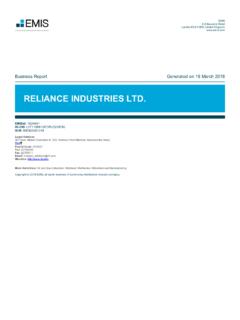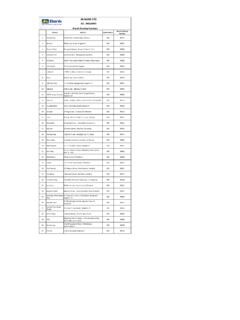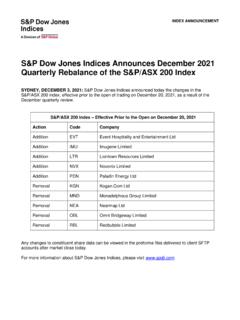Transcription of TOYOBO CO., LTD.
1 Technical Information (Revised ) TOYOBO CO., LTD. ZYLON (PBO fiber) Technical Information (2005) Contents 1. Basic properties 2. Comparison with other high-performance fibers 3. Influence of twist on tensile properties 4. Creep properties 5. Thermal behavior TGA Analysis Isothermal weight loss Strength retention after thermal treatment Strength retention at high temperature with humidity Effect of temperature on strength and modulus Hot air shrinkage Flame resistance Combustion products 6. Light resistance 7. Chemical resistance Organic mediums Inorganic mediums Seawater 8. Moisture pick-up 9.
2 Miscellaneous Compressive strength Knot and loop strength Thermal expansion coefficient Heat capacity Abrasion resistance between fiber and metal 2 1. Basic Properties ZYLON (PBO fiber) is the next generation super fiber with strength and modulus almost doubles that of p-Aramid fiber. ZYLON shows 100 C higher decomposition temperature than p-Aramid fiber. The limiting oxygen index is 68, which is the highest among organic super fibers. There are two types of fibers, AS (as spun) and HM (high modulus). HM is different from AS in modulus, moisture regain and etc. ZYLON ASZYLON HMFilament (g/cm3) Strength(cN/dtex)3737(GPa) (kg/mm2)590590 Tensile Modulus(cN/dtex)11501720 (GPa)180270 (kg/mm2)1800028000 Elongation at break(%) regain(%) Temp.
3 ( C)650650 LOI6868 Thermal expansion coefficient--6x10-62. Comparison of mechanical properties with other fibers ZYLON has the highest tensile strength and tensile modulus among high-performance fibers. TenacityModulusElonga-tionDensityMoistur eRegainLOIHeatResistance*cN/dtexGPa cN/dtexGPa%g/cm3% CZylon (HM) *Melting or Decomposition Temperature3 The stress-strain curves of ZYLON compared with other high-performance fibers are shown below. 01234560123456 Strain (%)Stress(GPa)Zylon ASZylon HMp-Aramidp-Aramid HMcopoly-AramidCarbon3. Influence of twist on tensile properties ZYLON is shipped with zero twist. A certain twist has to be applied in order to measure its correct tensile strength.
4 These figures show the influence of twist factor on tensile strength and modulus for 555 dtex ZYLON yarn. For different dtex yarns, optimum twist level can be estimated by using twist factor. Twist factor is defined by the following formula. Twist factor (TF) = x (turns per inch) x (dtex) FactorStrength(cN/dtex)60080010001200140 0 Modulus(cN/dtex)Zylon AS 555dtex253035404505101520 Twist FactorTenacity(cN/dtex)12001400160018002 000 Modulus(cN/dtex)Zylon HM 555dtex4 4. Creep Properties ZYLON has superior creep resistance to p-Aramid fibers. (Creep means a non-recoverable strain after prolonged static loading.) When a certain load is applied to yarn, recoverable strain (initial strain) and non-recoverable strain are observed.
5 For ZYLON HM, non-recoverable strain after 100 hours under 50% of breaking load (Safety factor (SF)=2) is less than 5060708090100110100100010000 100000 100000010000000 Time to Failure(min)Stress(% of breaking load)1 10 102 103 104 105 106 107 Zylon HM19 (hr)Strain(%)Zylon ASZylon HMp-Aramidp-Aramid ParameterCreep parameters (slope of straight line in above figure) are compared with p-Aramid fibers. ZYLON shows less than half of creep parameter of p-Aramid fiber. Creep strain is measured under 50% of the breaking load for each fiber. Note that the actual load applied to ZYLON is almost double that of p-Aramid fiber.
6 Creep parameter under 50% of breaking strengthZylon ASZylon HMp-Aramidp-Aramid 10-4 Time to failure After a certain loading time, yarn breakage may occur. The above figure shows the relationship between time to failure and applied load level (ZYLON HM). Based on the extrapolation, 107 minutes (19 years) of time to failure can be estimated under 60% of the breaking strength. 5 5. Thermal properties Decomposition Temperature ZYLON has a 100 C higher decomposition temperature than p-Aramid fibers. Thermal gravimetric analysis charts in air and argon gas are shown below. The heating rate is 20 C/min. 0204060801000100 200 300 400 500 600 700 Temperature( C)Residual Weight(%)Zylon ASZylon HMp-Aramidp-Aramid HMcopoly-Aramidin Ar0204060801000100 200 300 400 500 600 700 Temperature( C)Residual Weight(%)Zylon ASZylon HMp-Aramidp-Aramid HMcopoly-Aramidin air Isothermal weight loss A significant difference of weight loss behavior is observed at 500 C between ZYLON and Aramid fibers.
7 020406080100050100150200 Time(min)Residual Weight(%)Zylon ASZylon HMp-Aramidp-Aramid HMcopoly-Aramid500 C020406080100050100150200 Time(min)Residual Weight(%)Zylon ASZylon HMp-Aramidp-Aramid HMcopoly-Aramid400 C 6 Strength retention after thermal treatment These figures show the effect of thermal treatment in air on residual strength. ZYLON HM shows a little higher heat resistance than ZYLON AS. 0204060801001101001000 Time(hr)Strength Retention(%)400 C350 C300 C250 C200 CZylon AS0204060801001101001000 Time(hr)Strength Retention(%)400 C350 C300 C250 C200 CZylon HM Strength retention after thermal treatment is compared with Aramid fibers at several temperatures.
8 0204060801000200400600 Time(hr)Strength Retention(%)ZYLON ASZYLON HMp-Aramidp-Aramid HMcopoly-Aramid250 C02040608010002505007501000 Time(hr)Strength Retention(%)Zylon ASZylon HMp-Aramidp-Aramid HMcopoly-Aramid200 C 7 020406080100050100150 Time (hr)Strength Retention(%)Zylon ASZylon HMp-Aramidp-Aramid HMcopoly-Aramid300 C02040608010001020 Time(hr)Strength Retention(%)30 Zylon ASZylon HMp-Aramidp-Aramid HMcopoly-Aramid350 C 02040608010005101520 Time (hr)Strength Retention(%)Zylon ASZylon HMp-Aramid HMcopoly-Aramid400 C02040608010003060901 Time(sec)Strength Retention(%)20 Zylon ASZylon HMp-Aramidp-Aramid HM500 C 8 Strength retention at high temperature with humidity The strength of ZYLON decreases in the condition of high temperature and high humidity.
9 The residual strength after a 50 hours treatment with saturated steam at 180 C is 40-50%, which is between p-Aramid and copoly-Aramid fiber. 0204060801000 1020304050 Time(hr)Strength Retention(%)Zylon ASZylon HMp-Aramidcopoly-Aramid180 C0204060801000 1020304050 Time(hr)Strength Retention(%)Zylon ASZylon HMp-Aramidcopoly-Aramid250 C The strength of ZYLON gradually decreases even at the temperature of less than 100 C in high humidity condition. ZYLON fiber should be stored free from high humidity at normal room temperatures. 0204060801000 20406080100 Time(day)Strength Retention(%)80 C60 C40 C80% RH02040608010002004006008001000 Time (day)Strength Retention (%)Room temperature andhumidity at warehouse40 C 80%RHZylon AS 555dtex9 Effect of temperature on strength and modulus The relative strength of ZYLON decreases from room temperature to 500 C.
10 ZYLON retains 40% of the room temperature strength even at 500 C. The temperature dependence of modulus is shown below. Even at 400 C, ZYLON retained 75% of modulus at room temperature. 0204060801000100200300400500 Temperature( C)Relative Strength(%)Zylon ASZylon HMp-Aramidp-Aramid HM0204060801000100200300400 Temperature( C)Relative Modulus(%)Zylon ASZylon HMp-Aramid HM Hot air shrinkage Shrinkage (permanent) after hot air treatment for 30 minutes without load was measured. ZYLON shows very low shrinkage as compared with other super fibers. ( C)Shrinkage(%)Zylon ASZylon HMp-Aramidcopoly-Aramid10 Flame resistance ZYLON shows extremely high flame resistance.
